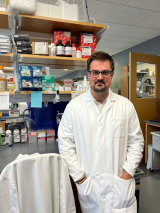Unraveling GABAergic interneuron-like lineage in H3G34-mutant hemispheric high-grade gliomas: their impact on network formation and invasion

Brain tumors are a major cause of cancer-related deaths in children, with high-grade gliomas (HGG) being particularly lethal. These tumors often have mutations in histone genes, occurring in a specific pattern during childhood development. Our research focuses on a subset called DHG-H3G34, marked by H3G34RV mutations. Our initial data reveal that these tumors have a cell population resembling interneurons in the brain, with altered gene expression and communication patterns. In experiments, DHG-H3G34 cells exhibited features associated with tumor invasion and resistance. In mice, these cells spread to distant brain regions, mirroring neuron migration in normal development. Our drug experiments suggest that a combination of inhibitors can reduce cell proliferation. Our study aims to, (1) map the spatial arrangement of these glioma cells, understanding how their communication networks and electrical activity promote tumor growth; (2) identify the migratory pattern of these cells within the brain; and (3) evaluate the effectiveness of a drug combination in reducing tumor growth in mouse models. This research addresses two challenges: understanding the biology of DHG-H3G34 tumors and revolutionizing treatment for children. By uncovering the unique features of this glioma subtype, we hope to pave the way for targeted treatments. Our approach shifts from traditional cytotoxic agents to precision medicine, tailored to the molecular profiles of DHG-H3G34 tumors.
Project Goal:
1) Analyze interneuron-like glioma cells in DHG-H3G34-mutant tumors to understand their spatial distribution, communication networks, and electrical activity, exploring their role in promoting tumor growth. 2) Investigate the invasive ability of glioma cells inside the mouse brain by monitoring preferred invasion routes in real-time to identify their movements within the parenchyma. 3) Assess the impact of a new dual combinatorial treatment strategy targeting proliferation and communication of tumor cells. I believe that by using compounds that block proliferation and communication (feature involved in cell migration) of glioma cells, I can stop the growth and reduce the invasiveness of DHG-H3G34-mutant tumors. My research focuses on finding weaknesses in a specific glioma subtype called DHG-H3G34. If successful, this could lead to new and effective ways to treat the disease it causes, which is fatal illness.
Project Update 2025:
Using a powerful new technique that shows which genes are active in specific areas of the tumor, we discovered that some tumor cells resemble a special type of brain cell called GABAergic interneurons. These are nerve cells that normally help calm brain activity using a chemical messenger called GABA. We found that these tumor cells express key components of the GABA system, including the transporter that packages GABA into vesicles and the receptor that responds to GABA signals. These features suggest that the tumor cells might actually be communicating with each other using GABA—similar to how real neurons do. To test this idea, we used 3D imaging tools to visualize areas where these GABA-related proteins cluster together, and we observed potential “communication zones” between tumor cells. Then, we measured the activity of these cells using a glowing calcium sensor and time-lapse microscopy. The tumor cells showed spontaneous electrical activity patterns, suggesting they might be wired to signal each other in a neuron-like way. This discovery challenges traditional views of how brain tumors behave. If confirmed, it could open up new treatment possibilities. For example, medications already used to treat seizures—such as GABA-blocking drugs—might be repurposed to interfere with this tumor-specific communication system and slow tumor growth. This novel approach could lead to new therapies for a disease that currently has very limited treatment options.

